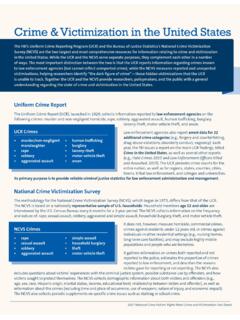Transcription of Deinstitutionalization: Its Impact on Community Mental ...
1 Page 40 The Alabama Counseling Association Journal, Volume 35, Number 1 Deinstitutionalization: Its Impact on Community Mental Health Centers and the Seriously Mentally Ill Stephen P. Kliewer Melissa McNally Robyn L. Trippany Walden University Abstract Deinstitutionalization has had a significant Impact on the Mental health system, including the client, the agency, and the counselor. For clients with serious Mental illness, learning to live in a Community setting poses challenges that are often difficult to overcome. Community Mental health agencies must respond to these specific needs, thus requiring a shift in how services are delivered and how Mental health counselors need to be trained.
2 The focus of this article is to explore the dynamics and challenges specific to deinstitution-alization, discuss implications for counselors, and identify solutions to respond to the identified challenges and resulting needs. State run psychiatric hospitals have traditionally been the primary component in the treatment of people with severe and persistent Mental illness. For many years, individuals with severe Mental illness (SMI) were kept out of the Community setting. This isolation occurred for many reasons: a) the attitude of the public about people with Mental illness, b) a belief that the mentally ill could only be helped in such settings, and c) a lack of resources at the Community level (Patrick, Smith, Schleifer, Morris & McClennon, 2006).
3 However, the institutional approach was not without its problems. A primary problem was the absence of hope and expecta-tion that patients would recover (Patrick, et al., 2006). In short, institutions seemed to become warehouses where mentally ill were kept for long periods of time with little expectation of improvement. In 1963, the Kennedy administration addressed the institutionalization of the severely mentally ill and the con-dition of state Mental hospitals. The result was the passage of the 1963 Community Mental Health Centers Act (CMHCA). The CMHCA had a tremendous Impact on the Mental health system in the United States and upon the profession of Mental health counseling.
4 This act not only restructured how services were provided but also who performed those services. No longer was treatment restricted to the medical professionals. Therapeutic services to the SMI were now relegated to a host of non-medical professionals. Previous to the CMHCA, Mental health counselors were primarily working with people who were struggling with issues such as marital conflict or developmental issues, but who were essentially healthy (Browers, 2005). Individuals with SMI, especially if it were persistent, were placed in hospitals and dealt with at the institutional level.
5 However, the development of the first antipsychotic medication in 1954 opened the door for Community -based treatment rather than lifelong institutionalization (Stubbs, 1998). The CMHCA legisla-tion brought people into the Community who exhibited more significant symptoms of Mental illness, thus cre-ating new challenges for the Mental health system at the Community level, as well as for Mental health coun-selors. Social, Cultural, and Political Context of the Deinstitutionalization It should not be surprising that such a dramatic shift in approach for treating individuals with SMI should emerge from the culture of the 1960 s.
6 The culture was distinct from the conservative lifestyle of the fifties and there was a revolution of thought and a radical shift in the framework of American life. This was a time Page 41 when the rights of individuals became highly valued, with both the civil rights movement and the feminist movement attacking beliefs and values that oppressed and limited populations (Goodwin, 2005). Goodwin suggested this was also a time dominated by youth, with the baby boomer generation moving into its teen years and young adulthood. This generation was shaped by powerful events including the war in Vietnam, the Civil Rights movement, women s liberation, the hippie movement, a newly emerging environmental move-ment, and even the space race (Dixon & Goldman, 2003; Goodwin, 2005).
7 It seems a logical conclusion in the midst of this rush toward positive social change that the plight of the mentally ill should get some attention and that an institutional approach to treatment should be challenged (Feldman, 2003). It should be noted that this era was also a time when, at the political level, a great deal of change was occur-ring. John F. Kennedy was a charismatic leader who created much hope in America (Goodwin, 2005). Presi-dent Kennedy seemed prepared to involve the government in social change. The CMHCA was a reflection of the political climate present during the days of the Kennedy administration (Dixon & Goldman, 2003; Feldman, 2003).
8 The change occurring in Mental health at the political level had actually begun during World War II, but culminated with the Joint Commission on Mental Health and Illness. After eight years of examina-tion, the Commission submitted a report which indicated that the nation needed to become less dependent upon hospitals and more dependent on non-traditional caregivers such as case workers, clergy and educators. This perspective was a significant factor leading to the CMHCA three years later (Feldman, 2003). Challenges of Deinstitutionalization The benefits of deinstitutionalization have been noted in the professional literature.
9 These benefits have been identified as independence and a better quality of life outside of institutions (Forrester-Jones et al., 2002), reduction in psychotropic medication needs (Hobbs, Newton, Tennant, Rosen & Tribe, 2002), and increased socialization and adaptability to change (Priebe, Hoffman, Isermann, & Kaiser, 2002). However, Iodice and Wodarski (1987) contended that while in theory it may have been a good idea, it may not have worked as well as intended. The individuals who were to receive the benefits of deinstitutionalization were often homeless, isolated, and victimized.
10 Some individuals with SMI who were released from institutions deteriorated, were reinstitutionalized, and some lost their lives (Honkonen, Henriksson, Kovisto, Stengard, & Salokangas, 2004; Iodice & Wodarski, 1987; Kelly & McKenna, 2004; Sealy & Whitehead, 2004). Kelly and McKenna (2004) suggested that the Community at large is frequently afraid of people with Mental illness, believing them to be dangerous. This belief often caused rejection, stigmatization, victimization , and harassment (French, 1987). Mentally ill clients thus become unsupported and at high risk for self harm.

















